Antibiotic prophylaxis for leptospirosis
- PMID: 38483067
- PMCID: PMC10938880
- DOI: 10.1002/14651858.CD014959.pub2
Antibiotic prophylaxis for leptospirosis
Abstract
Background: Leptospirosis is a global zoonotic and waterborne disease caused by pathogenic Leptospira species. Antibiotics are used as a strategy for prevention of leptospirosis, in particular in travellers and high-risk groups. However, the clinical benefits are unknown, especially when considering possible treatment-associated adverse effects. This review assesses the use of antibiotic prophylaxis in leptospirosis and is an update of a previously published review in the Cochrane Library (2009, Issue 3).
Objectives: To evaluate the benefits and harms of antibiotic prophylaxis for human leptospirosis.
Search methods: We identified randomised clinical trials through electronic searches of the Cochrane Hepato-Biliary Group Controlled Trials Register, CENTRAL, MEDLINE, Embase, LILACS, Science Citation Index Expanded, and other resources. We searched online clinical trial registries to identify unpublished or ongoing trials. We checked reference lists of the retrieved studies for further trials. The last date of search was 17 April 2023.
Selection criteria: We included randomised clinical trials of any trial design, assessing antibiotics for prevention of leptospirosis, and with no restrictions on age, sex, occupation, or comorbidity of trial participants. We looked for trials assessing antibiotics irrespective of route of administration, dosage, and schedule versus placebo or no intervention. We also included trials assessing antibiotics versus other antibiotics using these criteria, or the same antibiotic but with another dose or schedule.
Data collection and analysis: We followed Cochrane methodology. The primary outcomes were all-cause mortality, laboratory-confirmed leptospirosis regardless of the presence of an identified clinical syndrome (inclusive of asymptomatic cases), clinical diagnosis of leptospirosis regardless of the presence of laboratory confirmation, clinical diagnosis of leptospirosis confirmed by laboratory diagnosis (exclusive of asymptomatic cases), and serious adverse events. The secondary outcomes were quality of life and the proportion of people with non-serious adverse events. We assessed the risk of bias of the included trials using the RoB 2 tool and the certainty of evidence using GRADE. We presented dichotomous outcomes as risk ratios (RR) and continuous outcomes as mean difference (MD), with their 95% confidence intervals (CI). We used a random-effects model for our main analyses and the fixed-effect model for sensitivity analyses. Our primary outcome analyses included trial data at the longest follow-up.
Main results: We identified five randomised clinical trials comprising 2593 participants that compared antibiotics (doxycycline, azithromycin, or penicillin) with placebo, or one antibiotic compared with another. Four trials assessed doxycycline with different durations, one trial assessed azithromycin, and one trial assessed penicillin. One trial had three intervention groups: doxycycline, azithromycin, and placebo. Three trials assessed pre-exposure prophylaxis, one trial assessed postexposure prophylaxis, and one did not report this clearly. Four trials recruited residents in endemic areas, and one trial recruited soldiers who experienced limited time exposure. The participants' ages in the included trials were 10 to 80 years. Follow-up ranged from one to three months. Antibiotics versus placebo Doxycycline compared with placebo may result in little to no difference in all-cause mortality (RR 0.15, 95% CI 0.01 to 2.83; 1 trial, 782 participants; low-certainty evidence). Prophylactic antibiotics may have little to no effect on laboratory-confirmed leptospirosis, but the evidence is very uncertain (RR 0.56, 95% CI 0.25 to 1.26; 5 trials, 2593 participants; very low-certainty evidence). Antibiotics may result in little to no difference in the clinical diagnosis of leptospirosis regardless of laboratory confirmation (RR 0.76, 95% CI 0.53 to 1.08; 4 trials, 1653 participants; low-certainty evidence) and the clinical diagnosis of leptospirosis with laboratory confirmation (RR 0.57, 95% CI 0.26 to 1.26; 4 trials, 1653 participants; low-certainty evidence). Antibiotics compared with placebo may increase non-serious adverse events, but the evidence is very uncertain (RR 10.13, 95% CI 2.40 to 42.71; 3 trials, 1909 participants; very low-certainty evidence). One antibiotic versus another antibiotic One trial assessed doxycycline versus azithromycin but did not report mortality. Compared to azithromycin, doxycycline may have little to no effect on laboratory-confirmed leptospirosis regardless of the presence of an identified clinical syndrome (RR 1.49, 95% CI 0.51 to 4.32; 1 trial, 137 participants), on the clinical diagnosis of leptospirosis regardless of the presence of laboratory confirmation (RR 4.18, 95% CI 0.94 to 18.66; 1 trial, 137 participants), on the clinical diagnosis of leptospirosis confirmed by laboratory diagnosis (RR 4.18, 95% CI 0.94 to 18.66; 1 trial, 137 participants), and on non-serious adverse events (RR 1.12, 95% CI 0.36 to 3.48; 1 trial, 137 participants), but the evidence is very uncertain. The certainty of evidence for all the outcomes was very low. None of the five included trials reported serious adverse events or assessed quality of life. One study is awaiting classification. Funding Four of the five trials included statements disclosing their funding/supporting sources, and the remaining trial did not include this. Three of the four trials that disclosed their supporting sources received the supply of trial drugs directly from the same pharmaceutical company, and the remaining trial received financial support from a governmental source.
Authors' conclusions: We do not know if antibiotics versus placebo or another antibiotic has little or have no effect on all-cause mortality or leptospirosis infection because the certainty of evidence is low or very low. We do not know if antibiotics versus placebo may increase the overall risk of non-serious adverse events because of very low-certainty evidence. We lack definitive rigorous data from randomised trials to support the use of antibiotics for the prophylaxis of leptospirosis infection. We lack trials reporting data on clinically relevant outcomes.
Copyright © 2024 The Cochrane Collaboration. Published by John Wiley & Sons, Ltd.
Conflict of interest statement
TZW: none.
TP: none.
PM: none.
CS: none.
TE: none.
SMH: none.
HTM: none.
DMB: none.
NL: none.
Figures


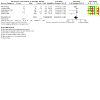
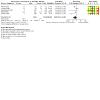


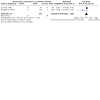
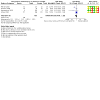
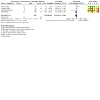

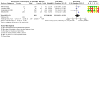
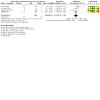
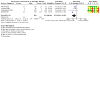
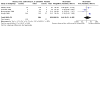


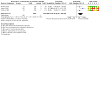
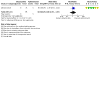

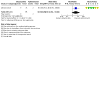

Update of
- doi: 10.1002/14651858.CD014959
References
References to studies included in this review
Alikhani 2018 {published data only}
-
- Alikhani A, Salehifar E, Zameni F, Rafiei A, Yazdani-charati J, Delavaryan L, et al. Comparison of azithromycin vs doxycycline prophylaxis in leptospirosis, a randomized double blind placebo-controlled trial. Journal of Infection in Developing Countries 2018;12(11):991-5. [DOI: 10.3855/jidc.10126] - DOI - PubMed
-
- IRCT2015052322383N1. Clinical trial azithromycin versus doxycycline chemoprophylaxis in leptospirosis in farmers. trialsearch.who.int/Trial2.aspx?TrialID=IRCT2015052322383N1 (first received 29 June 2016).
Gonsalez 1998 {published data only}
-
- Gonsalez CR, Casseb J, Monteiro FG, Paula-Neto JB, Fernandez RB, Silva MV, et al. Use of doxycycline for leptospirosis after high-risk exposure in Sao Paulo, Brazil. Revista do Instituto de Medicina Tropical de São Paulo 1998;40(1):59-61. - PubMed
Illangasekera 2008 {published data only}
-
- Illangasekera VL, Kularatne SA, Kumarasiri PV, Pussepitiya DM, Premaratne MD. Is oral penicillin an effective chemoprophylaxis against leptospirosis? A placebo controlled field study in the Kandy District, Sri Lanka. Southeast Asian Journal of Tropical Medicine and Public Health 2008;39:882-4. - PubMed
Sehgal 2000 {published data only}
-
- Sehgal SC, Sugunan AP, Murhekar MV, Sharma S, Vijayachari P. Randomized controlled trial of doxycycline prophylaxis against leptospirosis in an endemic area. International Journal of Antimicrobial Agents 2000;13:249-55. - PubMed
Takafuji 1984 {published data only}
-
- Takafuji ET, Kirkpatrick JW, Miller RN, Karwacki JJ, Kelley PW, Gray MR, et al. An efficacy trial of doxycycline chemoprophylaxis against leptospirosis. New England Journal of Medicine 1984;310:497-500. - PubMed
References to studies excluded from this review
Chusri 2014 {published data only}
-
- Chusri S, McNeil EB, Hortiwakul T, Charernmak B, Sritrairatchai S, Santimaleeworagun W, et al. Single dosage of doxycycline for prophylaxis against leptospiral infection and leptospirosis during urban flooding in southern Thailand: a non-randomized controlled trial. Journal of Infection and Chemotherapy 2014;20(11):709-15. [DOI: http://dx.doi.org/10.1016/ j.jiac.2014.07.016] - PubMed
-
- TCTR20131106001. Risk factors and chemoprophylaxis for leptospirosis infection during urban flooding in southern Thailand: a case-control study. trialsearch.who.int/Trial2.aspx?TrialID=TCTR20131106001 (date of registration 6 November 2013).
References to studies awaiting assessment
Shivaraj 2012 {published data only}
-
- Shivaraj B, Ts R, Anithraj BY, Bayari R. A study on prophylactic doxycycline to reduce the incidence of leptospirosis among paddy field farmers in a coastal district of India. International Journal of Infectious Diseases 2012;16(Suppl 1):E462.
Additional references
Aklil 2018
-
- Aklil MA, Aznida MZ, Azman A, Haneef MA, Him NA, Sharizman SA, et al. Effectiveness of antibiotics prophylaxis for leptospirosis among adults: a systematic review. Malaysian Journal of Applied Sciences 2018;3(2):46-56.
Bhardwaj 2010
Bharti 2003
-
- Bharti AR, Nally JE, Ricaldi JN, Matthias MA, Diaz MM, Lovett MA, et al. Leptospirosis: a zoonotic disease of global importance. Lancet Infectious Diseases 2003;3:757-71. - PubMed
Boutron 2022
-
- Boutron I, Page MJ, Higgins JP, Altman DG, Lundh A, Hróbjartsson A. Chapter 7: Considering bias and conflicts of interest among the included studies. In: Higgins JP, Thomas J, Chandler J, Cumpston M, Li T, Page MJ, Welch VA, editor(s). Cochrane Handbook for Systematic Reviews of Interventions Version 6.3 (updated February 2022). Cochrane, 2022. Available from training.cochrane.org/handbook/archive/v6.3.
Brett‐Major 2012
Brok 2008
-
- Brok J, Thorlund K, Gluud C, Wetterslev J. Trial sequential analysis reveals insufficient information size and potentially false positive results in many meta-analyses. Journal of Clinical Epidemiology 2008;61:763-9. - PubMed
Brok 2009
-
- Brok J, Thorlund K, Wetterslev J, Gluud C. Apparently conclusive meta-analyses may be inconclusive – Trial Sequential Analysis adjustment of random error risk due to repetitive testing of accumulating data in apparently conclusive neonatal meta-analyses. International Journal of Epidemiology 2009;38(1):287-98. - PubMed
Budihal 2014
Castellini 2018
CDC 2018
-
- Center for Disease Control and Prevention. Leptospirosis: fact sheet for clinicians. www.cdc.gov/leptospirosis/pdf/fs-leptospirosis-clinicians-eng-508.pdf (accessed 16 November 2021).
Chierakul 2014
-
- Chierakul W. Leptospirosis. In: Farrar J, Hotez PJ, Junghanss T, Kang G, Lalloo D, White NJ, editors(s). Manson's Tropical Diseases. 23 edition. London (UK): Saunders Ltd., 2014:433-40. [DOI: 10.1016/C2010-0-66223-7] - DOI
Costa 2015
Covidence [Computer program]
-
- Covidence systematic review software. Melbourne, Australia: Veritas Health Innovation, accessed on 14 August 2023. Available at covidence.org.
Deeks 2022
-
- Deeks JJ, Higgins JP, Altman DG. Chapter 10: Analysing data and undertaking meta-analyses. In: Higgins JP, Thomas J, Chandler J, Cumpston M, Li T, Page MJ, Welch VA, editor(s). Cochrane Handbook for Systematic Reviews of Interventions Version 6.3 (updated February 2022). Cochrane, 2022. Available from training.cochrane.org/handbook/archive/v6.3.
Eldridge 2021
-
- Eldridge S, Campbell MK, Campbell MJ, Drahota AK, Giraudeau B, Reeves BC, et al. Revised Cochrane risk of bias tool for randomized trials (RoB 2). Additional considerations for cluster-randomized trials (RoB 2 CRT). drive.google.com/file/d/1yDQtDkrp68_8kJiIUdbongK99sx7RFI-/view (accessed 12 June 2023).
Enzler 2011
Fergusson 2002
Galloway 2020
-
- Galloway RL, Schafer IJ, Stoddard RS. Travel-related infectious diseases – leptospirosis. wwwnc.cdc.gov/travel/yellowbook/2024/infections-diseases/leptospirosis (accessed 14 August 2023).
Gartlehner 2019
Goarant 2016
GRADEpro GDT [Computer program]
-
- GRADEpro GDT. Hamilton (ON): McMaster University (developed by Evidence Prime), (accessed 14 August 2023). Available from gradepro.org.
Griffith 2006
-
- Griffith ME, Hospenthal DR, Murray CK. Antimicrobial therapy of leptospirosis. Current Opinion in Infectious Diseases 2006;19(6):533-7. - PubMed
Guidugli 2000
Haake 2015
Higgins 2020
-
- Higgins JP, Li T, Sterne J. Revised Cochrane risk of bias tool for randomized trials (RoB 2). Additional considerations for crossover trials. drive.google.com/file/d/18Ek-uW8HYQsUja8Lakp1yOhoFk0EMfPO/view (accessed 14 August 2023).
Higgins 2022a
-
- Higgins JP, Thomas J, Chandler J, Cumpston M, Li T, Page MJ, Welch VA, editor(s). Cochrane Handbook for Systematic Reviews of Interventions Version 6.3 (updated February 2022). Cochrane, 2022. Available from training.cochrane.org/handbook/archive/v6.3.
Higgins 2022b
-
- Higgins JP, Savović J, Page MJ, Elbers RG, Sterne JA. Chapter 8: Assessing risk of bias in a randomized trial. In: Higgins JP, Thomas J, Chandler J, Cumpston M, Li T, Page MJ, Welch VA, editor(s). Cochrane Handbook for Systematic Reviews of Interventions Version 6.3 (updated February 2022). Cochrane, 2022. Available from training.cochrane.org/handbook/archive/v6.3.
Higgins 2022c
-
- Higgins JP, Eldridge S, Li T. Chapter 23: Including variants on randomized trials. In: Higgins JP, Thomas J, Chandler J, Cumpston M, Li T, Page MJ, Welch VA, editor(s). Cochrane Handbook for Systematic Reviews of Interventions Version 6.3 (updated February 2022). Cochrane, 2022. Available from training.cochrane.org/handbook/archive/v6.3.
Higgins 2022d
-
- Higgins JP, Li T, Deeks JJ. Chapter 6: Choosing effect measures and computing estimates of effect. In: Higgins JP, Thomas J, Chandler J, Cumpston M, Li T, Page MJ, Welch VA, editor(s). Cochrane Handbook for Systematic Reviews of Interventions Version 6.3 (updated February 2022). Cochrane, 2022. Available from training.cochrane.org/handbook/archive/v6.3.
ICH‐GCP 2016
-
- International Council for Harmonisation of technical requirements for pharmaceuticals for human use (ICH). ICH Harmonised Guideline. Integrated addendum to ICH E6(R1): guideline for good clinical practice E6(R2). Available from database.ich.org/sites/default/files/E6_R2_Addendum.pdf (accessed 14 August 2023).
Israel 2011
Jakobsen 2014
Karpagam 2020
-
- Karpagam KB, Ganesh B. Leptospirosis: a neglected tropical zoonotic 13 infection of public health importance – an updated review. European Journal of Clinical & Microbiology and Infectious Diseases 2020;39(5):835-46. - PubMed
Kobayashi 2001
Koizumi 2020
-
- Koizumi N. Laboratory diagnosis of leptospirosis. Methods in Molecular Biology (Clifton, N.J.) 2020;2134:277-87. - PubMed
Lasserson 2022
-
- Lasserson T, Churchill R, Chandler J, Tovey D, Higgins JP. Standards for the conduct and reporting of new Cochrane intervention reviews, reporting of protocols and the planning, conduct and reporting of updates. community.cochrane.org/mecir-manual (accessed 12 June 2023).
Lefebvre 2022
-
- Lefebvre C, Glanville J, Briscoe S, Littlewood A, Marshall C, Metzendorf M-I, et al. Technical Supplement to Chapter 4: Searching for and selecting studies. In: Higgins JP, Thomas J, Chandler J, Cumpston MS, Li T, Page MJ, Welch VA, editor(s). Cochrane Handbook for Systematic Reviews of Interventions Version 6.3 (updated February 2022). Cochrane, 2022. Available from training.cochrane.org/handbook/archive/v6.3.
Levett 2001
Lewis 2001
Lundh 2017
Mavridis 2014
McKenzie 2022a
-
- McKenzie JE, Brennan SE, Ryan RE, Thomson HJ, Johnston RV, Thomas J. Chapter 3: Defining the criteria for including studies and how they will be grouped for the synthesis. In: Higgins JP, Thomas J, Chandler J, Cumpston M, Li T, Page MJ, Welch VA, editor(s). Cochrane Handbook for Systematic Reviews of Interventions Version 6.3 (updated February 2022). Cochrane, 2022. Available from training.cochrane.org/handbook/archive/v6.3.
McKenzie 2022b
-
- McKenzie JE, Brennan SE. Chapter 12: Synthesizing and presenting findings using other methods. In: Higgins JP, Thomas J, Chandler J, Cumpston M, Li T, Page MJ, Welch VA, editor(s). Cochrane Handbook for Systematic Reviews of Interventions Version 6.3 (updated February 2022). Cochrane, 2022. Available from training.cochrane.org/handbook/archive/v6.3.
Moffa 2019
-
- Moffa M, Brook I. Tetracyclines, glycylcyclines, and chloramphenicol. In: Mandell, Douglas, and Bennett's Principles and Practice of Infectious Diseases. 9th edition. Philadelphia (PA): W.B. Saunders, 2019:318-37.
Munoz‐Zanzi 2020
Nemeth 2006
Page 2021a
Page 2021b
Page 2022
-
- Page MJ, Higgins JP, Sterne JA. Chapter 13: Assessing risk of bias due to missing results in a synthesis. In: Higgins JP, Thomas J, Chandler J, Cumpston M, Li T, Page MJ, Welch VA, editor(s). Cochrane Handbook for Systematic Reviews of Interventions Version 6.3 (updated February 2022). Cochrane, 2022. Available from training.cochrane.org/handbook/archive/v6.3.
Pequeno 2020
Perez 2021
Peryer 2022
-
- Peryer G, Golder S, Junqueira D, Vohra S, Loke YK. Chapter 19: Adverse effects. In: Higgins JP, Thomas J, Chandler J, Cumpston M, Li T, Page MJ, Welch VA, editor(s). Cochrane Handbook for Systematic Reviews of Interventions Version 6.3 (updated February 2022). Cochrane, 2022. Available from training.cochrane.org/handbook/archive/v6.3.
RevMan 2023 [Computer program]
-
- Review Manager (RevMan). Version 5.8.0. The Cochrane Collaboration, 2023. Available at revman.cochrane.org.
Rodrigo 2014
-
- Rodrigo C, Silva NL, Goonaratne R, Samarasekara K, Wijesinghe I, Parththipan B, et al. High dose corticosteroids in severe leptospirosis: a systematic review. Transactions of the Royal Society of Tropical Medicine and Hygiene 2014;108(12):743-50. - PubMed
Schneider 2017
-
- Schneider MC, Velasco-Hernandez J, Min K, Leonel DG, Baca-Carrasco D, Gompper ME, et al. The use of chemoprophylaxis after floods to reduce the occurrence and impact of leptospirosis outbreaks. International Journal of Environmental Research and Public Health 2017;14(6):594-615. [DOI: 10.3390/ijerph14060594] - DOI - PMC - PubMed
Schünemann 2013
-
- Schünemann H, Brożek J, Guyatt G, Oxman A, editors. GRADE handbook for grading quality of evidence and strength of recommendations. Updated October 2013. The GRADE Working Group, 2013. Available from gdt.gradepro.org/app/handbook/handbook.html.
Schünemann 2022
-
- Schünemann HJ, Vist GE, Higgins JP, Santesso N, Deeks JJ, Glasziou P, et al. Chapter 15: Interpreting results and drawing conclusions. In: Higgins JP, Thomas J, Chandler J, Cumpston M, Li T, Page MJ, Welch VA, editor(s). Cochrane Handbook for Systematic Reviews of Interventions Version 6.3 (updated February 2022). Cochrane, 2022. Available from training.cochrane.org/handbook/archive/v6.3.
Soler 2021
-
- Soler MC, Mogliani S, Benítez ST, Cabillón LN, Rollié RD, Martins GM. Glucocorticoids in leptospira alveolar hemorrhage [Glucocorticoides en hemorragia alveolar por leptospira]. Medicina 2021;81:107-10. - PubMed
Sterne 2019
Storebø 2018
-
- Storebø OJ, Pedersen N, Ramstad E, Kielsholm ML, Nielsen SS, Krogh HB, et al. Methylphenidate for attention deficit hyperactivity disorder (ADHD) in children and adolescents - assessment of adverse events in non-randomised studies. Cochrane Database of Systematic Reviews 2018, Issue 5. Art. No: CD012069. [DOI: 10.1002/14651858.CD012069.pub2] - DOI - PMC - PubMed
Suneth 2011
Thai 2008
Thorlund 2010
Thorlund 2017
-
- Thorlund K, Engstrøm J, Wetterslev J, Brok J, Imberger G, Gluud C. User Manual for Trial Sequential Analysis (TSA); 2nd edition. Copenhagen Trial Unit, 2017. Available from ctu.dk/tsa/learn-more (accessed 12 June 2023).
Torgerson 2015
TSA 2021 [Computer program]
-
- TSA – Trial Sequential Analysis. Version 0.9.5.10 Beta. Copenhagen: Copenhagen Trial Unit, 2021. Available from ctu.dk/tsa/downloads/.
Vijayachari 2008
-
- Vijayachari P, Sugunan AP, Shriram AN. Leptospirosis: an emerging global public health problem. Journal of Biosciences 2008;33(4):557-69. - PubMed
Vinetz 2020
-
- Vinetz JM, Watt G. Leptospirosis. In: Ryan ET, Hill DR, Solomon T, Aronson NE, Endy TP, editors(s). Hunter's Tropical Medicine and Emerging Infectious Diseases. 10th edition. Edinburgh (UK): Elsevier, 2020:636-40.
Wetterslev 2008
-
- Wetterslev J, Thorlund K, Brok J, Gluud C. Trial sequential analysis may establish when firm evidence is reached in cumulative meta-analysis. Journal of Clinical Epidemiology 2008;61(1):64-75. - PubMed
Wetterslev 2009
Wetterslev 2017
WHO 2003
-
- World Health Organization. Human leptospirosis: guidance for diagnosis, surveillance and control. Revista do Instituto de Medicina Tropical de São Paulo 2003;45(5):292-310. [DOI: 10.1590/S0036-46652003000500015] - DOI
WHO 2020
-
- World Health Organization. Fact sheets – health emergency and disaster risk management (EDRM). www.who.int/publications/m/item/health-emergency-and-disaster-risk-manag... (accessed 14 August 2023).
References to other published versions of this review
Brett‐Major 2008
Brett‐Major 2009
Publication types
MeSH terms
Substances
LinkOut - more resources
Full Text Sources
Medical
Miscellaneous

